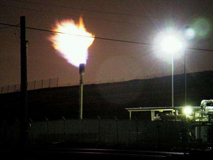 |
Date Announced: 03 Aug 2021
Enables laser spectrometry to determine relative concentration of different methane isotopolgues.
Photo of landfill burn off flare. Credit: Eddie Hagler/Public Domain.
National Physical Laboratory, Teddington, UK -- Methane concentrations in the atmosphere have more than doubled over the last 150 years and mitigation of methane emissions will play a vital role in enabling climate change mitigation strategies.
Understanding current and future methane inventories at a regional scale will be a key element in developing and implementing successful solutions. Current regional scale isotopic methane data is not available at a high enough frequency to enable comparison to the models that are used to derive national emission estimates.
In order to improve these current data sets, more in-situ measurements of methane isotopic data are required and current techniques do not provide the required sensitivity and frequency.
Improving isotopic methane measurements on regional scales is just one of our focuses within National Physical Laboratory's (NPL) EAM team. This work centers on the potential for using isotopic information to understand the source of methane emissions.
The work includes the development and validation of novel Greenhouse Gas (GHG) monitoring abilities that can contribute continuous real-time data on atmospheric methane over long-term time periods.
Boreas described in journal Analytical Chemistry
Recently, members of the EAM group have published results from a new instrument, called Boreas, in the journal Analytical Chemistry. This instrument, developed at NPL, samples a large volume of air, then cryogenically separates the methane from air and is sensitive enough to provide continuous, hourly data of isotopic methane emissions to a high precision.
Utilizing low temperature separation of methane from an air sample, Boreas enables an increase in the methane fraction of up to 250 times, allowing researchers to use laser spectrometry to understand the relative concentration of different methane isotopolgues which indicate the source of the gas.
Using this technique we are able to achieve measurement precision near those of conventional isotope ratio mass spectrometer (IRMS) measurements. Using Boreas we're able to do continuous, hourly measurements over a long time period, something the IRMS technique is unable to achieve.
Boreas has now been deployed at the NPL atmospheric monitoring site at Heathfield, which is part of the network of sites performing measurements for the deriving emissions related to climate change (DECC) project.
The results from Boreas have the potential to help in attributing methane emissions sources on a regional scale, and to answer questions such as whether sources or sinks are dictating the current trend in atmospheric methane concentration.
This will contribute to validating the UK greenhouse gas emissions inventory and aid in informing policy makers of the effectiveness of climate change mitigation activities and of our efforts to reduce methane emissions from the many different sources which contribute to methane concentration in the atmosphere
Explore further
More information: Chris Rennick et al, Boreas: A Sample Preparation-Coupled Laser Spectrometer System for Simultaneous High-Precision In Situ Analysis of δ13C and δ2H from Ambient Air Methane, Analytical Chemistry (2021). DOI: 10.1021/acs.analchem.1c01103 Journal information: Analytical Chemistry
E-mail: https://www.npl.co.uk/contact/
Web Site: https://www.npl.co.uk
| © 2026 SPIE Europe |
|